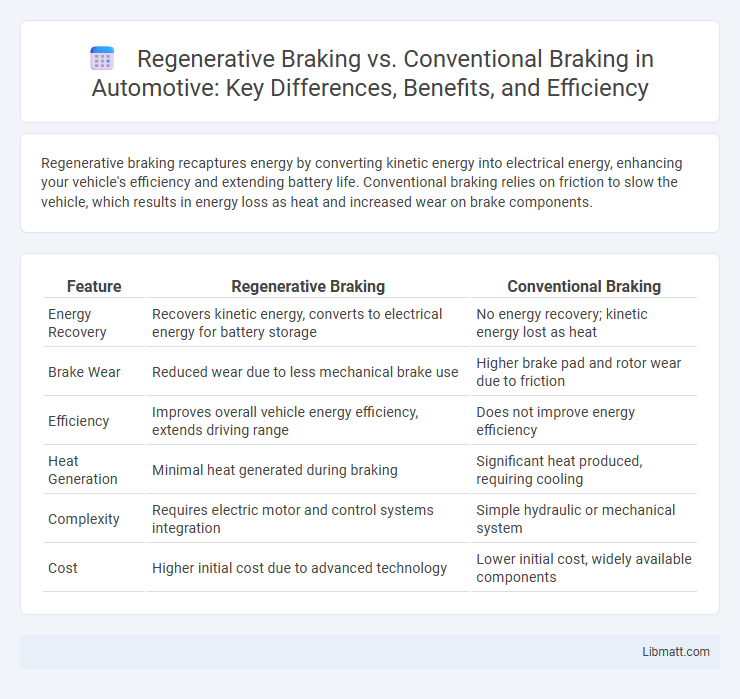Regenerative braking recaptures energy by converting kinetic energy into electrical energy, enhancing your vehicle's efficiency and extending battery life. Conventional braking relies on friction to slow the vehicle, which results in energy loss as heat and increased wear on brake components.
Table of Comparison
| Feature | Regenerative Braking | Conventional Braking |
|---|---|---|
| Energy Recovery | Recovers kinetic energy, converts to electrical energy for battery storage | No energy recovery; kinetic energy lost as heat |
| Brake Wear | Reduced wear due to less mechanical brake use | Higher brake pad and rotor wear due to friction |
| Efficiency | Improves overall vehicle energy efficiency, extends driving range | Does not improve energy efficiency |
| Heat Generation | Minimal heat generated during braking | Significant heat produced, requiring cooling |
| Complexity | Requires electric motor and control systems integration | Simple hydraulic or mechanical system |
| Cost | Higher initial cost due to advanced technology | Lower initial cost, widely available components |
Introduction to Braking Systems
Braking systems are essential components in vehicles, designed to reduce speed and ensure safety by converting kinetic energy into other forms. Conventional braking dissipates this energy as heat through friction between brake pads and discs, leading to wear and energy loss. Regenerative braking captures and converts kinetic energy back into electrical energy, enhancing energy efficiency and extending battery life in electric and hybrid vehicles.
What is Regenerative Braking?
Regenerative braking is an energy recovery mechanism used in electric and hybrid vehicles that captures kinetic energy during deceleration to recharge the battery. Unlike conventional braking, which dissipates energy as heat through friction, regenerative braking converts kinetic energy into electrical energy, improving overall energy efficiency. This technology reduces wear on brake components and extends driving range by recycling energy that would otherwise be lost.
How Conventional Braking Works
Conventional braking operates by applying friction via brake pads against a rotating disc or drum attached to the vehicle's wheels, converting kinetic energy into thermal energy that dissipates as heat. This energy conversion results in wear on brake components and loss of energy that cannot be recovered. The mechanism relies on hydraulic or mechanical systems to amplify the driver's input force, ensuring effective deceleration and vehicle control.
Key Differences Between Regenerative and Conventional Braking
Regenerative braking captures kinetic energy during deceleration, converting it into electrical energy to recharge the vehicle's battery, enhancing energy efficiency and extending driving range. Conventional braking relies on friction to slow down the vehicle, dissipating kinetic energy as heat, which results in energy loss and brake wear. Your choice between the two systems impacts vehicle maintenance costs and overall sustainability, especially in electric and hybrid models.
Energy Efficiency Comparison
Regenerative braking recovers kinetic energy during deceleration, converting it into electrical energy stored in the battery, resulting in higher overall energy efficiency compared to conventional braking systems that dissipate energy as heat through friction. Conventional braking systems exhibit energy loss typically exceeding 60%, while regenerative braking can recover up to 70% of the energy that would otherwise be wasted, significantly improving vehicle efficiency and extending driving range. This energy efficiency advantage makes regenerative braking a critical technology for electric and hybrid vehicles aiming to reduce fuel consumption and emissions.
Environmental Impact
Regenerative braking significantly reduces environmental impact by converting kinetic energy into electrical energy, which is then stored for later use, decreasing overall energy consumption and lowering greenhouse gas emissions. In contrast, conventional braking dissipates energy as heat, contributing to increased fuel consumption and higher carbon emissions. Your choice of regenerative braking supports sustainable transportation by enhancing energy efficiency and minimizing ecological footprint.
Maintenance and Longevity
Regenerative braking systems significantly reduce wear on traditional brake components by using electric motors to decelerate vehicles, extending the lifespan of brake pads and rotors compared to conventional braking systems. Conventional brakes rely entirely on friction, leading to faster deterioration and more frequent maintenance requirements. The lower mechanical wear in regenerative braking translates to reduced maintenance costs and improved overall vehicle longevity.
Performance in Different Driving Conditions
Regenerative braking excels in urban stop-and-go traffic by recovering kinetic energy and enhancing efficiency, making it ideal for city driving with frequent stops. Conventional braking offers consistent performance in high-speed or emergency scenarios, providing reliable heat dissipation and stronger stopping power on highways and steep descents. Combining both systems optimizes overall braking performance, balancing energy recovery and safety across diverse driving conditions.
Application in Electric and Hybrid Vehicles
Regenerative braking in electric and hybrid vehicles captures kinetic energy during deceleration, converting it into electrical energy to recharge the battery, thus improving energy efficiency and extending driving range. Conventional braking relies on friction to slow the vehicle, dissipating energy as heat, which results in energy loss and increased wear on brake components. The integration of regenerative braking systems in modern electric and hybrid vehicles reduces dependence on mechanical brakes, enhances overall vehicle efficiency, and lowers maintenance costs.
Future Trends in Braking Technology
Regenerative braking systems are rapidly advancing with integration of smart energy recovery technologies and AI-driven control algorithms, enhancing vehicle efficiency and battery longevity. Conventional braking is evolving through the development of advanced friction materials and sensor-based adaptive braking systems to improve safety and reduce wear. Your driving experience will benefit from these innovations as vehicles increasingly combine regenerative and conventional methods for optimal performance and sustainability.
Regenerative braking vs Conventional braking Infographic

 libmatt.com
libmatt.com